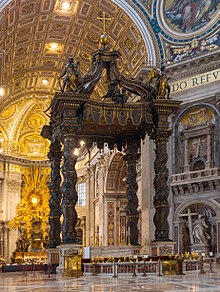
Back قبر القديس بطرس Arabic Müqəddəs Pyotrun məzarı Azerbaijani Tomba de Sant Pere Catalan Petrusgrab German Τάφος του Αποστόλου Πέτρου Greek Tombo de Sankta Petro Esperanto Tumba de San Pedro Spanish San Petriren hilobia Basque Tombe de saint Pierre French Makam Santo Petrus ID

| Part of a series of articles on |
| Peter in the Bible |
|---|
 |
| In the New Testament |
| Other |
Saint Peter's tomb is a site under St. Peter's Basilica that includes several graves and a structure said by Vatican authorities to have been built to memorialize the location of Saint Peter's grave. St. Peter's tomb is alleged near the west end of a complex of mausoleums, the Vatican Necropolis, that date between about AD 130 and AD 300.[1] The complex was partially torn down and filled with earth to provide a foundation for the building of the first St. Peter's Basilica during the reign of Constantine I in about AD 330. Though many bones have been found at the site of the 2nd-century shrine, as the result of two campaigns of archaeological excavation, Pope Pius XII stated in December 1950 that none could be confirmed to be Saint Peter's with absolute certainty.[2] Following the discovery of bones that had been transferred from a second tomb under the monument, on June 26, 1968, Pope Paul VI said that the relics of Saint Peter had been identified in a manner considered convincing.[3] Circumstantial evidence was provided to support the claim.[4]
The grave allegedly lies at the foot of the aedicula beneath the floor. The remains of four individuals and several farm animals were found in this grave.[5] In 1953, after the initial archeological efforts had been completed, another set of bones were found that were said to have been removed without the archeologists' knowledge from a niche (loculus) in the north side of a graffiti wall that abuts the red wall on the right of the aedicula. Subsequent testing indicated that these were the bones of a 60- to 70-year-old man.[6] Margherita Guarducci argued that these were the remains of Saint Peter and that they had been moved into a niche in the graffiti wall from the grave under the aedicula "at the time of Constantine, after the peace of the church" (313).[7] Antonio Ferrua, the archaeologist who headed the excavation that uncovered what the Catholic Church says is Saint Peter's Tomb, said that he was not convinced that the bones that were found were those of Saint Peter.[8]
- ^ Guarducci, Margherita. "THE TOMB OF ST. PETER". Hawthorn Books. Archived from the original on 29 April 2009. Retrieved 27 May 2009.
- ^ Roger T. O'Callaghan, Roger ., "Vatican Excavations and the Tomb of Peter", The Biblical Archaeologist 16.4 (December 1953) p.71. Of the coins found with the bones, in a hollow beneath the niche of the earliest shrine on the site "one was of the Emperor Antoninus Pius (138–161), six were from the years 168–185, and more than forty were from the years 285–325,".
- ^ "Udienza generale, 26 giugno 1968 | Paolo VI". Vatican.va (in Italian). Retrieved 19 November 2021.
- ^ Schultz, Colin (25 November 2013). "Are These the Bones of Saint Peter?". Smithsonian Magazine. Retrieved 24 October 2021.
- ^ Walsh 2011, chap.9.
- ^ Walsh 2011.
- ^ Guarducci, Margherita. "The Remains of Peter". Archived from the original on 7 May 2009. Retrieved 28 May 2009.
- ^ "Antonio Ferrua, 102; Archeologist Credited as Finding St. Peter's Tomb". Los Angeles Times. 29 May 2003. Retrieved 13 February 2012.